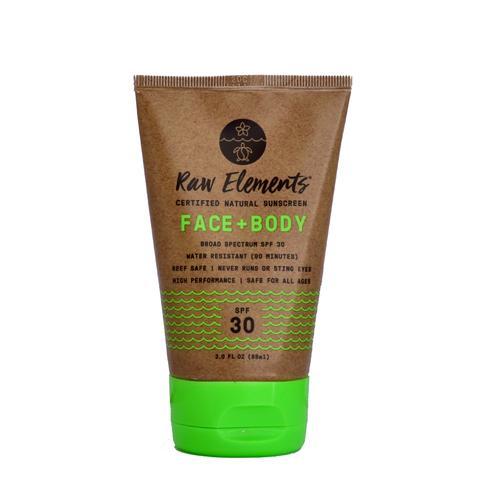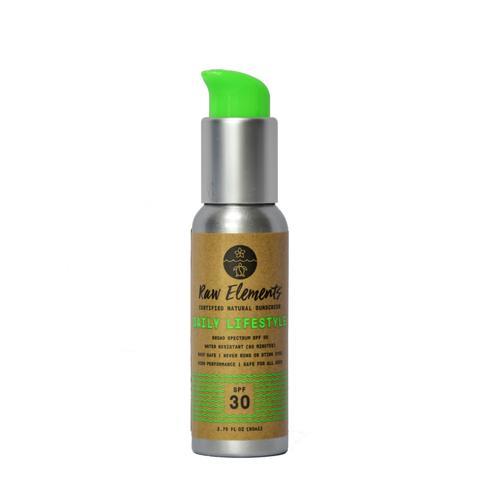Cutting Through The SPF Label: A Practical Field Guide To Choosing & Using Sunscreen Effectively
Posted by Brian A. Guadagno - CEO, Raw Elements on 23rd May 2018
2018 is truly shining new light and focus on the sunscreen category. Chemical SPF ingredients, how they impact human health and now conclusively how they impact the health of our environment have been finally thrust into public view. Scientific studies now definitively show how SPF chemicals like oxybenzone and octinoxyate are responsible for causing bleaching to our coral reefs while also being linked to a slew of human health issues as they are hormone and endocrine disrupters. With label claims, ingredient listings and testing translations being so confusing, it is important for consumers to understand how to go about choosing sunscreens that are safe and effective. Equally as crucial and maybe even more challenging is how to go about using this sunscreen effectively.

It is important to first understand how UV radiation effects our skin. First and foremost, sunlight truly is a source of life energy for all living organisms. As humans, we need a healthy amount of sun daily to ensure we acquire adequate Vitamin D which is necessary for cellular function. Overexposure to UV radiation is where issues arise and needs to be avoided. There are two types of ultraviolet rays; UVB and UVA. UVA is comprised of UVA1 & UVA2. UVB rays are primarily responsible for reddening or “burning” of the outer layers of skin. UVB damage and sunburning can cause skin cancer. Each incidence of sunburning to a peel is believed to increase one’s risk of Skin Cancer by 50%. UVA rays, the “tanning” rays, are deeper penetrating and responsible for longer term skin “aging”, wrinkles and cellular damage. Overexposure to UVA rays is now believed to be a key contributor toward the most aggressive any potentially deadly form of skin cancer, Melanoma. To easily remember the effects of the two types of ultraviolet rays, think; UVB-burning/sun burn, UVA-aging/tan. Overexposure to both UVA and UVB rays is carcinogenic and can cause Skin Cancer.
Fact: Skin cancer rates continue to rise as does the use of sunscreen. The most important job of a sunscreen is to attain and maintain balanced, broad spectrum protection - safely and effectively . Broad Spectrum protection refers to a product’s ability to effectively mitigate the harmful effects of both UVB and UVA rays. Under the FDA regulations, a product marked ‘Broad Spectrum’ will now be mandated to filter a balanced, amount of UVA relative to its SPF (UVB) claim. One crucial point most consumers are unaware of is this: Regardless of the SPF number, the manner and amount of sunscreen the consumer applies will dramatically affect sunscreen performance. The average consumer applies 25% of the necessary amount of sunscreen per application - taking a would be SPF 30 down to about an SPF of 5! It is critical to seek sunscreens that contain active ingredients which provide broad spectrum protection and just as critical to be certain to apply and reapply properly. In 2018 there is enough data to determine sunscreen chemicals in the Oxybenzone, Octinoxate families should be avoided. These chemicals are known hormone/endocrine disrupters and by design pass trough the skin into the body. A study by The CDC found Oxybenzone in 97% of Americans’ urine that were tested.
How To Choose Sunscreen Effectively
1. Choose Broad Spectrum Non Nano Zinc Oxide protection. There are 18 FDA approved active ingredients in sunscreen. While many of these offer UVB protection, only four offer any UVA protection. Zinc Oxide is the only single, broad spectrum active. Non Nano Zinc Oxide is a mineral that physically blocks the entire range of UVA & UVB. Non Nano Zinc Oxide sits on top of skin, is large enough to not absorbed as the others and is a non skin irritant. Look for Non Nano Zinc Oxide percentages to be over 18% and ideally the only active ingredient. Non Nano Zinc Oxide is reef safe. Titanium Dioxide does not cover the full range of UVA radiation by itself.
2. Use Broad Spectrum SPF 30, beware of lower or higher numbers. It is a widely accepted that Broad Spectrum SPF 30 is the benchmark needed to provide adequate UVB & balanced UVA protection. In FDA mandated testing, SPF 30 sunscreens filter 97% of UVB rays while SPF 50 only filters 1% more at 98% and SPF 100 would only offer 2% more at 99%. In real life application, however, it is very unlikely that filtering more than 97% of UVB rays is plausible. Furthermore, extremely high SPF claims provide a false sense of security, double or triple the amount of chemicals and skin absorption while risking excessive UVA exposure.
3. Choose ʻWater Resistant 80 Minutesʼ, a proven track record, & avoid spray on products. The term ‘Water Resistant 80 Minutes’ is regulated by the FDA. It represents a sunscreenʼs ability to remain effective after 80 minutes exposure to water. ‘Waterproof’ and ‘All Day Protection’ claims are misleading and not allowed. A product that is Water Resistant 80 Minutes will likely offer better sweat resistance as well. Ultimately, a Water Resistant 80 Minutes sunscreen that has performed well for you in the past is a wise choice in the future. Avoid sprays or powder sunscreens at all costs. These applicators expel excess amounts of chemical ingredients which immediately become lung inhalants and pose a health hazard. Additionally, these chemicals go airborne and indiscriminately pollute the environment. Furthermore it is nearly impossible to determine the correct dosage application and quite often skin coverage is not effective.

How To Use Sunscreen Effectively
1. Sunscreen is the last line of defense, not the first. It is imperative that a complete approach toward sun protection is used. Contrary to popular belief, no sunscreen alone will keep you totally protected. It is always suggested to stay out of peak sun between the hours of 10am and 2pm, seek shade and wear protective clothing and hats. Avoid extended periods of exposure, never allow skin to sunburn and avoid a deep tan, as both UVB and UVA rays cause skin cancer.
2. Apply more than enough. In order for sunscreen to be effective as advertised, the correct amount must be applied. The FDA regulates that all sunscreens must be SPF tested in the amount of 2mg of formula per square centimeter of skin. What this means is that an adult wearing only shorts must use one full ounce of sunscreen per application to cover all the exposed skin properly. Approximately a teaspoon size amount is needed to adequately protect the face, ears and neck. Using less than the correct amount drastically reduces the sunscreens ability to protect the skin and the SPF claim will not be met. Apply enough to leave an even, visible film over desired coverage area, then rub in to the desired look.
3. Apply early, reapply often. The vast majority of chemical sunscreens require early application, at least 30 minutes prior to sun exposure to be effective. Reducing this time period will reduce the effectiveness of the sunscreen. Non Nano Zinc Oxide, as a physical barrier is effective the moment it is evenly applied to the skin. It is imperative to reapply sunscreen often, at least every eighty minutes during long periods of sun exposure. Regardless how ʻWater Resistantʼ a formula claims to be, it is wise to reapply after any water exposure, sweating, or towel drying. Applying early and reapplying often will give the sunscreen the best chance to perform effectively.


